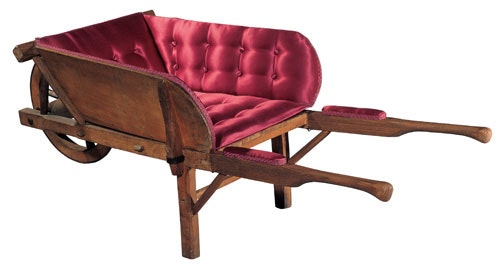The utopian aspirations of Modernism still function as design’s foundational myth, even if it is the gospel of a church at which few pray any more.
But if you consider those elements that are still in play, Surrealism, the other primary creative trend of 20th century high culture, has been even more influential. Desire, surprise, dream, disruption, unconscious attachment, fetishism – these Surrealist themes have all now been co-opted to the world of brand. Of course, a product should be sexy – ask any brand manager. Shorn of the critical purchase they once had as a result of Surrealism’s synthesis of Karl Marx and Sigmund Freud, these terms now operate freely and unselfconsciously as competence in consumerism. What was a critical engagement with nascent consumerism in the early 20th century has become a style within consumerism.
So, for instance, Selfridges can commission designer/artist Rolf Sachs to create ‘Surrealist’ windows for its London store, as well as selling ‘Surreal’ pieces of his, such as ‘a bottled clock’. Of course, the shop window – and the mannequin in particular – were favoured tropes of Surrealism. Retailers were quick to return the compliment, already adopting Surrealism as a window display-style in the 1930s.
This difficult interplay is the subject of Surreal Things: Surrealism and Design, the show opening later this month at London’s Victoria & Albert Museum. Not only our own recuperation and castration of Surrealism, but the willing participation of so many Surrealist artists in commercial ventures is documented. From furniture as well-known as Salvador Dali’s Mae West Lips sofa or Lobster Telephone and Meret Oppenheim’s fur-covered teacup or Table with Bird’s Legs, the fashion designs of Elsa Schiaparelli to the paintings of René Magritte (who was also a jobbing graphic designer), it is clear that an interplay with the commercial world of design was there almost from the very beginning. In the words of the show’s curator Ghislaine Wood, ‘Surrealism carried the seeds of its own commercialisation.’ And this was not lost on its proponents, despite their avowedly critical stance. ‘I used to claim that the world would end not with a great book, but with a wonderful advertisement for heaven or hell,’ announced André Breton, Surrealism’s high priest in 1924.
The essays in the accompanying catalogue take different stances on the complex relationship between art and design in Surrealism, from the distasteful and critical, to the celebration of its adoption of the easily readable language of advertising.
Selecting the objects of Surrealist and Surrealist-influenced design will have been a much tougher task than that which faced the curators of last year’s Modernism show at the V&A, to which this show is an important corrective; it is territory that hasn’t been anything like as well chartered. The catalogue covers the ground impressively: from interior design to fashion photography, the commercial world’s assimilation of Surrealism is comprehensively surveyed. One of the more remote, yet intriguing arguments of the show is a connection between the ‘biomorphic’ design in the US in the 1940s and 1950s, exemplified by the furniture of Isamu Noguchi, and the Surrealist tradition exemplified by the painting of Joan Miró and the sculpture of Jean Arp.
The selection of objects makes a persuasive case for design to reconsider its heritage. Many of the influential designs of the recent past, such as Jurgen Bey’s Tree Trunk Bench, take on a different complexion against this backdrop. Given the power the Droog aesthetic still asserts over the imagination of furniture design students, it’s an influence likely to continue.
Likewise, a Surrealist idiom remains pervasive in contemporary graphics and advertising. However, perhaps the funniest example is a very direct engagement – Philippe Starck’s Ceci n’est pas une brouette. For just under €5000 (£3370, you get a replica of Oscar Dominguez’ Brouette, created in 1937, which became famous as a result of Man Ray’s photograph. It’s good to remember that not everything is as it seems. l
Surreal Things: Surrealism and Design runs at the Victoria & Albert Museum, Cromwell Road, London SW7 from 29 March to 22 July

- Industries in this article
- Brands in this article







